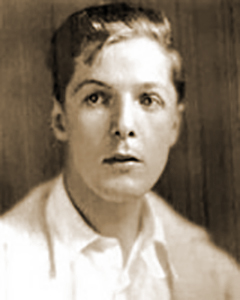
People active in the silent era and people who keep the silent era alive.
Copyright © 1999-2025 by Carl Bennett and the Silent Era Company.
All Rights Reserved.
|
|

|
|
Photograph: Stephen Lyons collection.
|
Gareth Hughes
Born 23 August 1894 in Llanelli, South Wales, United Kingdom, as William John Hughes.
Died 1 October 1965 in the Motion Picture Country Home in Woodland Hills, Los Angeles, California, USA,
of hypoxia.
Gareth Hughes was born in Llanelli, South Wales. He was a gifted child and developed a love of theatre from an early age. His father was an award-winning speaker at local competitions. At the age of sixteen, he left home for London and a career in theatre.
Gareth worked with a number of touring repertoire companies, playing in Shakespeare and popular melodramas. In late 1912, he became involved in a movement to promote Welsh national drama throughout the UK and in London. In early 1914, he sailed to New York with The Welsh Players to perform Change at the Booth Theatre, New York. The play was not as well received as expected but, when his fellow actors returned to the UK in May 1914, Gareth chose to stay in the USA.
After work with Guy Bates Post, James O’Neill and the Irish Theatre of America, Gareth became the toast of Broadway in Beulah M. Dix’s Moloch, stealing the best reviews of the season in but a brief appearance. Gareth was catapulted to theatrical stardom and film offers began to come in.
Gareth’s first film was for Jacques Tyrol in 1915 and several others followed. However, his first true break was an appearance in Mrs. Wiggs of the Cabbage Patch (1919) with May McAvoy for Famous Players-Lasky Corporation. In 1919, Clara Kimball Young persuaded Gareth to Hollywood to play the juvenile lead, her brother, in Eyes of Youth (1919), a film in which Rudolph Valentino played a small part. Gareth was teamed with Viola Dana in The Chorus Girl’s Romance (1920), which brought him to even greater attention.
In September 1920, he became Metro’s ‘boy star’ and was lined up for five films with George D. Baker and S-L Pictures. No sooner signed, Gareth took a leave of absence to film Sentimental Tommy (1921) at Paramount’s new studios on Long Island, New York. Author James M. Barrie himself had selected Gareth for the part.
Gareth’s film career peaked in the early to mid twenties. He worked with many great directors and stars but, by 1923, starring roles were turning into cameos in good films such as Enemies of Women (1923) and The Spanish Dancer (1923), and then, toward the end of the twenties, to starring and lesser roles in poor, low budget films. He is almost pitiful in a small part as a retard in the talkie Mister Antonio (1929), a sad debut in talking pictures. His next and final appearance in films was in the Richard Talmadge flop, Scareheads (1931).
His greatest love was theatre and he never fully respected film. Sentimental Tommy was the only one of his forty-five films for which he expressed a liking. Gareth’s boyish looks and slight physique had brought him success in vulnerable, emotional and artistic parts but, in 1925 and aged 31, the crossover between boy and man failed to provide a sufficiently rugged or sustainable image to keep him with the high flyers. Gareth, at times, had shown a surprising ability for light comedy but neither that nor his dramatic ability could prevent the slide.
In 1936, Gareth returned from obscurity and became director of religious and Shakespearean drama for the WPA’s Federal Theatre Project in Los Angeles, enjoying his last great reviews as an actor as Shylock in The Merchant of Venice with Estelle Winwood in 1937. Towards the end of the 1930’s he experienced a calling to God and, in 1944 (as Brother David), became a lay missionary on the Pyramid Lake Indian Reservation at Nixon, Nevada. His last official career role was as Welsh dialect coach to Bette Davis and others on The Corn is Green (1945).
He served his beloved Paiutes, not without difficulty and controversy, until 1958, when he returned home to Wales to retire. After years in the desert, the UK climate was not to his liking and he moved to the Motion Picture Country Home at Woodland Hills, California, where he acted as unofficial chaplain. He baptised Clara Kimball Young at the home not long before her death, and officiated at Edmund Gwenn’s funeral. The rigours of the desert and a lung condition brought on by sorting second-hand clothes for the Paiutes contributed to his failing health. Gareth Hughes died in 1965.
— Biography by Stephen Lyons
|
Website : Stephen Lyons’ Gareth Hughes
|
|




































